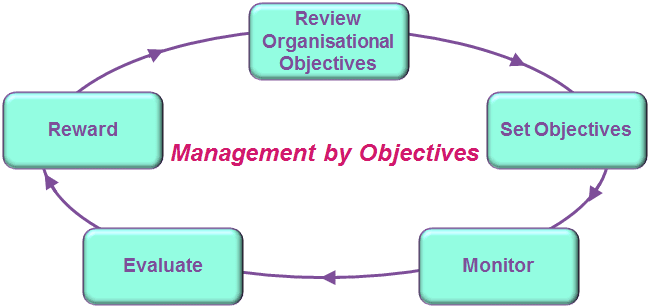What is Management by Objectives?
What are its salient features? Can it be uniformly applied in all countries, in all organizations and at all times? Substantiate.
The concept of ‘Management by Objectives’ (MBO) was first given by Peter Drucker in 1954. It can be defined as a process whereby the employees and the superiors come together to identify common goals, the employees set their goals to be achieved, the standards to be taken as the criteria for measurement of their performance and contribution and deciding the course of action to be followed.
The essence of MBO is participative goal setting, choosing course of actions and decision making. An important part of the MBO is the measurement and the comparison of the employee’s actual performance with the standards set. Ideally, when employees themselves have been involved with the goal setting and the choosing the course of action to be followed by them, they are more likely to fulfill their responsibilities.
UNIQUE FEATURES AND ADVANTAGES OF MBO
The principle behind Management by Objectives (MBO) is to create empowered employees who have clarity of the roles and responsibilities expected from them, understand their objectives to be achieved and thus help in the achievement of organizational as well as personal goals.
Some of the important features and advantages of MBO are:
- Clarity of goals – With MBO, came the concept of SMART goals i.e. goals that are:
- Specific
- Measurable
- Achievable
- Realistic, and
- Time bound.
- The goals thus set are clear, motivating and there is a linkage between organizational goals and performance targets of the employees.
- The focus is on future rather than on past. Goals and standards are set for the performance for the future with periodic reviews and feedback.
- Motivation – Involving employees in the whole process of goal setting and increasing employee empowerment increases employee job satisfaction and commitment.
- Better communication and Coordination – Frequent reviews and interactions between superiors and subordinates helps to maintain harmonious relationships within the enterprise and also solve many problems faced during the period.
MBO in Practice
You’ll find MBO programs in many business, health care, educational, government, and nonprofit organizations. Most organizations, in fact, make some use of MBO features because managers find that goals give people direction and it doesn’t make sense to establish goals and then fail to evaluate whether or not they’re being achieved. MBO’s popularity should not be construed to mean that it always works. There area number of documented cases in which MBO was implemented but failed to meet management’s expectations. A close look at those cases, however, indicates that the problems rarely lie with MEO’s basic components. Rather, the culprits tend to be factors such as unrealistic expectations regarding results, lack of commitment by top management, and an inability or unwillingness by management to allocate rewards based on goal accomplishment. Nevertheless, MBO provides managers with the vehicle for implementing goal-setting theory.

Be the first to comment on "Management by Objectives"